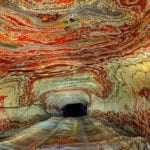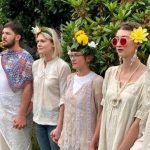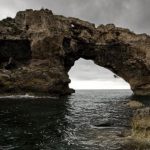 Creepy
Creepy  Creepy
Creepy  Movies and TV
Movies and TV 10 Movies That Get Elite Jobs Right, According to Experts
 Weird Stuff
Weird Stuff 10 Times Real Laws Were Based on Bizarre Hypotheticals
 Animals
Animals 10 Inspiring Tales of Horses Being Human
 Mysteries
Mysteries Top 10 Haunting Facts About the Ghost Ship MV Alta
 History
History 10 Surprising Stories About the Texas Rangers
 Humans
Humans 10 Philosophers Who Were Driven Mad by Their Own Theories
 Miscellaneous
Miscellaneous 10 Video-Game-Worthy Weapons and Armors from History
 Weird Stuff
Weird Stuff 10 Psychics Who Accurately Predicted Wartime Events
 The Arts
The Arts 10 Pieces of Art Inspired by a Broken Heart
 Creepy
Creepy 10 Death Superstitions That Will Give You the Creeps
 Movies and TV
Movies and TV 10 Movies That Get Elite Jobs Right, According to Experts
 Weird Stuff
Weird Stuff 10 Times Real Laws Were Based on Bizarre Hypotheticals
Who's Behind Listverse?

Jamie Frater
Head Editor
Jamie founded Listverse due to an insatiable desire to share fascinating, obscure, and bizarre facts. He has been a guest speaker on numerous national radio and television stations and is a five time published author.
More About Us Animals
Animals 10 Inspiring Tales of Horses Being Human
 Mysteries
Mysteries Top 10 Haunting Facts About the Ghost Ship MV Alta
 History
History 10 Surprising Stories About the Texas Rangers
 Humans
Humans 10 Philosophers Who Were Driven Mad by Their Own Theories
 Miscellaneous
Miscellaneous 10 Video-Game-Worthy Weapons and Armors from History
 Weird Stuff
Weird Stuff 10 Psychics Who Accurately Predicted Wartime Events
 The Arts
The Arts 10 Pieces of Art Inspired by a Broken Heart
10 Famous Frescoes to Add to Your Must-See Travel Bucket List
The origins of fresco painting generally remain vague. It is believed that they originated about 1500 BC during the Minoan civilization in Greece. The rest of Europe only caught up on fresco painting around the 15th century, when it was perfected by great Renaissance art masters like Raphael, Michelangelo, and Leonardo Da Vinci (who were painters before they became the names of teenage mutant ninja turtles).
Fresco paintings were usually done on walls by applying paint pigment on fresh limestone plaster, which, when dry, becomes permanent. Fresco secco (dry fresco) is the process of soaking dry walls with limewater and painting while wet, which is useful for retouching frescoes. These two types of painting require great skill and meticulous planning.
Here are some of the most famous and beautiful frescoes found around the world to put under “must see” on your travel bucket list—even if you aren’t an art enthusiast. Some are available to see either on or near their original sites, while others are being conserved in museums worldwide.
Related: Top 10 Forgotten Artifacts Rediscovered In Museums
10 Behold, 2017 by Ali Cavanaugh
True frescoes are no longer done today on the same scale as in the Renaissance era, but the modern era has produced quite a few talented fresco painters, such as Russian-born iLia Anossov, trained Italian art conservator Elisabetta Covizzi Perfetti, and biblical fresco painter Ben Long, a student of Pietro Annigoni.
Catching the eye nowadays, though, are the dreamlike watercolor paintings by American Ali Cavanaugh, which are described as “modern frescoes.” She paints on wet kaolin clay panels using translucent watercolor pigment with synthetic brushes on white surfaces, giving her paintings a sense of being backlit. Her work is displayed in exhibitions and accessible through prints and books.
Wherever your world travels take you, you are sure to find frescoes from more modern artists.[1]
9 The Paintings of Sigiriya
Be sure to add the Sigiriya paintings in central Sri Lanka to your list. King Kasyapa established his lavish kingdom (477-495 AD) in Sigiriya. Initially, he had a 200-meter-tall (656-foot) rock painted white in an attempt to create an image of the Buddhist mythological city Alakamanda.
Not liking the look, he ordered his architects to decorate the western face with non-religious paintings, hence the beautifully detailed fresco pictures depicting 500 half-naked women in vibrant colors.
The process of painting this fresco lustro (adding a mild binding agent to pigments) ensemble was complicated, with bamboo scaffolding covering the rock, leaving stonemasons and painters to get materials up the wall by hand. Only 20 of the paintings are left today but are in excellent condition—even after being exposed to the elements for over 1,600 years.[2]
8 The Last Supper by Leonardo da Vinci
Living and working in the same era as Michelangelo, Da Vinci was considered one of the Renaissance’s greatest fresco painters. The 6-meter (15-foot) high and almost 8.8-meter (29-foot) wide fresco, The Last Supper, was painted on a wall in the Convent of Santa Maria delle Grazie in Milan, Italy, in 1498. Today, it is still being preserved and exhibited. The fresco depicts the biblical event of Jesus’ last night having a meal with his disciples, during which he revealed his betrayer, who later gave him over to the authorities to be crucified in Jerusalem.
The Last Supper, influenced by paintings of his time, is not contextually correct. According to various biblical accounts, the disciples would have been younger than portrayed, and they would have reclined for their meal and not sitting upright facing the onlooker. That being said, it might just have been a technique deployed by Da Vinci to make all the participants visible to the viewer—just as modern film and television camera footage displays today.
This fresco is not as well preserved as other murals from the same period due to da Vinci painting it on a stone surface and sealing it with tempura, which causes moisture to collect on the surface, triggering many restoration attempts to preserve it.[3]
7 Rare 12th-Century Fresco Surviving the Crusades
When visiting the Israel Museum in Jerusalem, make sure not to miss an extremely rare find of fresco painting. A 9-meter (29.5-foot) long, 12th-century Gethsemane fresco was found in 1999 during excavations near the Garden of Gethsemane. Buildings, which were part of the Abbey of St. Mary of the Valley of Jehoshaphat, were uncovered—one of the few churches that hadn’t been destroyed by Saladin or the Crusaders.
The painting was the largest to come from archaeological excavations in Israel at the time, and its restoration process was among the most complicated ever done. The preserved parts of the fresco apparently show a scene where Mary and John the Baptist beg Jesus for forgiveness on behalf of all humanity. Unfortunately, only the bottom parts of the figures are visible in the main picture, with Jesus sitting in the center, Mary to his right, and John the Baptist to his left.
Added with colorful floral tendrils on either side is a Latin saying by Saint Augustine: “Who injures the name of an absent friend, may not at this table as guest attend.” This was apparently meant for guests who visited the monastery to dine.[4]
6 The Last Judgement by Giorgio Vasari
The massive arched fresco, The Last Judgement, another Italian Renaissance painting, was started by Giorgio Vasari in 1572. Sadly, Vasari died in 1574, before its completion. The project was finished by Federico Zuccaro five years later. The style is reminiscent of Michelangelo, of whom Vasari was a great admirer.
It was designed to instill both reverence and fear among the attending congregation with a depiction of the twenty-four elders looking down onto choirs of angels and groups of saints, personifying the gifts of the Holy Spirit, the virtues, and the beatitudes on the lower terraces. On the lowest tier, and closest to see from underneath is the gloomy depiction of hell overflowing with tormented unbelievers.
Visit the Cathedral Of Santa Maria Del Fiore in Florence, Italy, to see this fantastic artwork in person.[5]
5 The Frescoes of Akrotiri
Early frescoes in Greece were limited to simple monochrome walls painted in red and black—like the pictures of some athletic silhouettes often associated with Olympic Games literature. The Minoans, living in Knossos, Crete, were one of the earliest cultures to paint natural landscapes in the form of frescoes without any humans present in the scenes. With improvements in the quality of plaster and pigments—and possible influences from Egypt and the Near East—walls with beautifully colored decorations of nature and everyday life illustrations were found in excavations after volcanic eruptions buried them temporarily.
During mining activities for the volcanic deposits of tephra on the island of Santorini—to be used to construct the Suez Canal in the mid-19th century—many of the antiquities found are now displayed in the National Archaeological Museum’s Thera Gallery in Athens. Some of the excavated frescoes found in the settlement of Akrotiri in Thera (Santorini) include beautiful nature scenes and the famous Akrotiri boxers. This exhibition is a must-see when visiting Athens.[6]
4 The Investiture of Zimri-Lim
One of the oldest and most highly valued frescoes in the world is The Investiture of Zimri-Lim, which adorned a wall in the royal palace in Mari, Syria, believed to be from 18 BC. The painting depicts the ceremony in which Zimri-Lim was anointed as king in a ritual involving the worship of the ancient Mesopotamian goddess Ishtar, also known as the ancient Sumerian goddess Inanna.
The fresco, whose painter is unknown, was discovered by archaeologists in 1936 while digging through the ruins of the once-great city-state. Due to fire damage, the painting is poorly preserved, and restoration work to it is done regularly by the Louvre in Paris, where it now resides.[7]
3 Go Rock Art Safari-ing in Africa
Rock Art, also called Bushman Art or Boesmantekeninge (in Afrikaans), are paintings and etchings done by the San People on rocks in the open air and on cave walls in various parts of Southern Africa. Some of these paintings are well over 3,000 years old, with prehistoric art in the Blombos Cave in the Western Cape apparently dating back over 70,000 years. South Africa has some of the best-preserved, most beautiful, and advanced examples of rock art to see.
Rock art primarily displays pictures of people and animals. Although researchers aren’t sure why these pictures were painted, one can speculate that it was driven by the human urge for self-expression, the necessity to leave messages, or even serving as a way of record-keeping. Whatever the reason—they are amazing examples of early fresco-like art.
Apart from the Western Cape, rock art can be found in the Limpopo and KwaZulu-Natal provinces. The Ukhahlamba-Drakensberg National Park is a UNESCO World Heritage site housing almost 520 rock shelters with about 30,000 images painted 4,000 years ago using plant sap, animal blood, and natural ochre.[8]
2 The Almost-Perfectly Preserved Frescoes of Pompeii
At around noon on August 24, AD 79, the cities of Herculaneum, Stabiae, Oplontis, and Boscoreale, along with Pompeii (population between 10,000 and 20,000), were buried under 6 to 7 meters (19 to 23) of volcanic ash when Mount Vesuvius erupted. Situated near Naples in Italy, Pompeii is the best known of the communities hit by the tragedy when all life perished on that fateful day.
After about seventeen centuries, these cities were discovered when diggings for a tunnel started in the early 1700s. Initial recoveries of mosaics, sculptures, and parts of frescoes were moved to the Archaeological Museum in Naples. But between 1760 and 1804, excavations were better coordinated, and onsite restorations began.
Frescoes portraying historical and mythological pictures, domestic and allegorical scenes, portraits, landscapes, and still lifes were found throughout the city—almost perfectly preserved. One of the best-known Pompeiian frescoes is a round medallion called Woman with Wax Tablets and Stylus (Sappho)—typical of the style of the era of portraying women holding tablets and styluses to prove their proficiency at housekeeping.
However, some of the frescoes recovered depict a seedier and more erotic side of Pompeii life. The walls of brothels were painted, depicting people engaged in various sexual acts, which is how a “customer” could choose what he wanted. But these paintings were not limited to only brothels. A fresco uncovered by archaeologists in 2018 in what appeared to be the bedroom of a home showcased the Greek myth of Leda and the swan. The explicit painting shows a semi-naked Leda sensually draped over a chair with the swan sitting in her lap while nuzzling her neck.
Although these frescoes were done by local painters, it is said that Renoir, when visiting Pompeii in 1881, was amazed by their skillful work.[9]
1 The Creation of Adam by Michelangelo
Probably the best-known fresco of all must be Michelangelo’s The Creation of Adam (circa 1512), displayed on the Sistine Chapel ceiling in Vatican City. The 280 cm × 570 cm (9 ft 2 in × 18 ft 8 in) fresco is a portrayal of the creation of man from the book of Genesis in the Bible. It forms part of an ensemble of biblical events decorating the ceiling of the chapel. It resembles Michelangelo’s characteristic sculpture-like paintings, differing from typical creation paintings from that era and before.
The fresco depicts two main characters—God, as an old and grey but masculine man, clothed simply, and Adam, laying back in relaxation, at ease in his Creator’s presence. Other role-players in the scene are apparently wingless angels supporting the God-figure and a woman underneath his left shoulder with a young child next to her.
Scholars are still divided on the precise translation of various parts of the painting, with some arguing that the woman must be Eve, the first woman, waiting to be created from Adam’s rib. Others argue it to be Mary, the mother of Jesus, with the young child figure to be her future son. The meaning of the touching of hands is God giving life to Adam—as the name of the painting depicts and as it was commissioned. However, modern interpreters are looking for other meanings, most of which raise more questions than answers. The Creation of Adam remains one of the most beautiful art pieces ever created, and digital and printed images are often used in anything from quote backgrounds to ad campaigns.[10]








